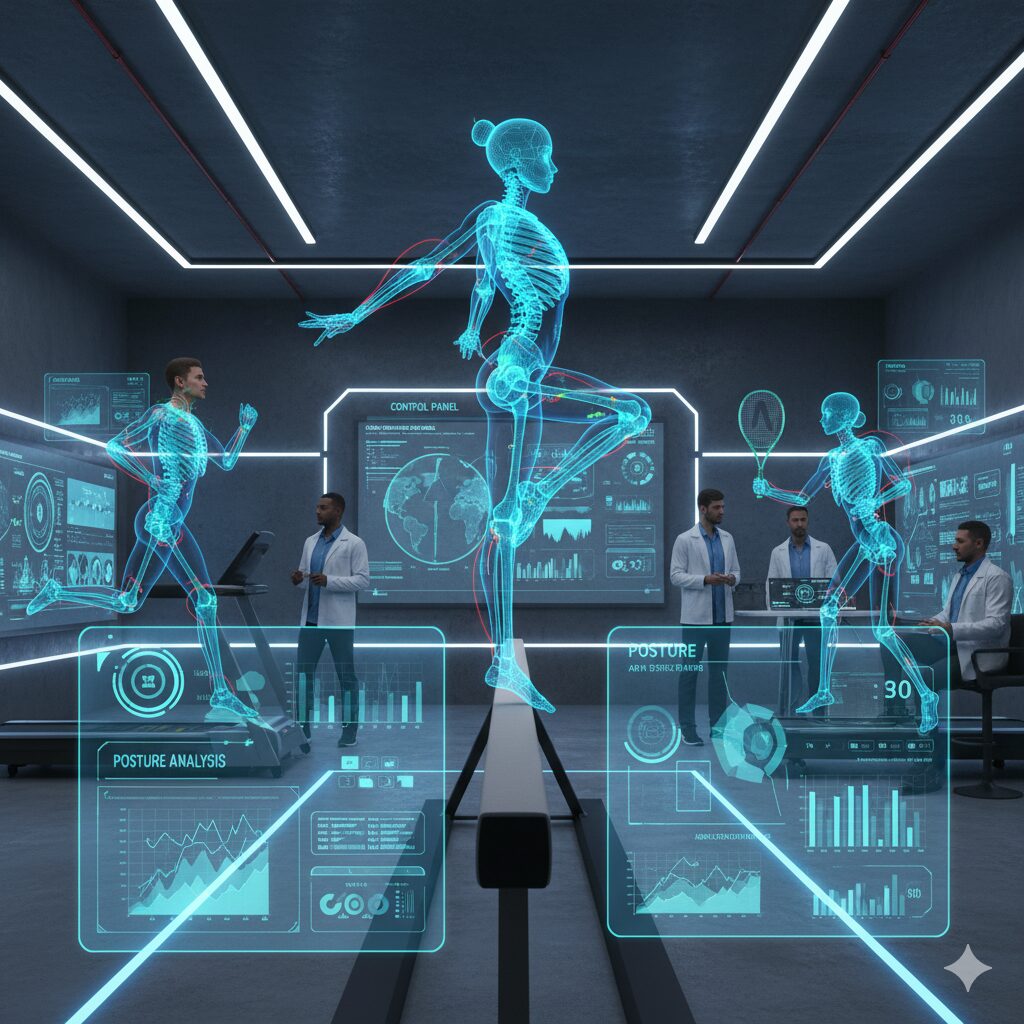
There is an old anecdote told in computer science circles: “If you’re raising money, it’s AI. If you’re hiring people, it’s machine learning. If you’re doing the work, it’s linear regression.” Like so many new technologies as they emerge, buzz words designed to evoke emotion and attract investment can get in the way of a working definition that is readily understandable.
At its core, Artificial Intelligence (AI) can be defined as an aspect of computational systems, which perform functions typically associated with human intelligence (Russell & Norvig, 2021). These include activities such as learning, reasoning, problem-solving, perception, and decision-making. These tasks might use cutting-edge deep learning techniques through to traditional statistical analyses, well over 100 years old.
Whichever definition is used, it is undeniable that AI is now permeating just about every part of the sport landscape. Examples include:
- Performance analysis: analyzing three-dimensional skeletal tracking of athletes obtained from computer vision to assist with technique improvement and the prevention of injuries,
- Fan engagement: Hyper-personalization of the fan experience, including tailored recommendations via a team’s app and 3D-rendered animations of players,
- Media: Automatically generated highlights, statistical graphics and match commentary for live broadcasts, and
- Officiating: semi-automated offside detection in football and line calling in a range of sports.
But knowing where and when to use AI matters more than simply knowing what’s possible. Opting out of AI is clearly no longer viable. To thrive in the future, sport organizations need a clear stance, complete with a working strategy and operational processes to match.
This article outlines key steps in developing an AI Action Plan, providing a resource that can be employed by any sport organization. By following these steps, an organization can learn to not only maximize the efficiency and effectiveness gains made from adopting AI but also help to reduce its inherent risks and potential negative impacts.
Setting the AI philosophy

AI’s fast ongoing growth combined with its broad impact will reshape sport. A clear philosophy that is future proof will help to ensure organizations can remain agile in the coming years as both they and AI continue to change. Key questions include:
- What is the scope?
Should AI be used across the entire organization, or excluded from areas with ethical concerns (for example, athlete health data)? Is there evidence that AI performs better than current practices? An organization may also resist the adoption of AI in cases where the benefits are not yet well established. Is it appropriate to use AI in scenarios where it cannot be interpreted as to how it has arrived at a certain decision? Who is accountable for AI-driven decisions?
- Why is it wanted?
Motivations range from solving a specific problem, like player evaluation or increase revenue to improving an existing process that may be functioning inefficiently. Sometimes it may simply be motivated by a desire to not fall behind other sports who are perceived to have been using AI successfully. In many situations outside of sport, AI has also been employed to reduce operational costs. Whatever the reasons, it should be well-informed, clearly communicated to the key stakeholders prior to engagement and used to guide later evaluations.
- How will its impact be assessed?
Is this assessment based on improvements to efficiency, as measured by dollars or staff hours saved? How much better than an existing process does the AI need to be in order to warrant the investment? Central to answering these questions should be a consideration of the values and culture of the sport. For instance, despite AI producing objective improvements, an organization may still seek to not utilize it due to the adverse effect it may have on the workplace in terms of skillsets and the daily interactions that the athlete will experience. Eventually AI’s direct impact may be hard to distinguish as it becomes integrated with other processes or combined with human judgement and intervention. It also serves to think about AI’s impact broadly, beyond the direct benefits. Importantly, what is the effect on the sport organization and athletes?
Frameworks to assist organizations with the assessment of AI are now becoming more common, with prominent examples emerging in the United States (National Institute of Standards & Technology, 2023), Canada (Ontario Government, 2023) and Australia (NSW Department of Customer Service, 2024).
AI Readiness Assessment

Once the philosophical approach to AI has been developed, organizations should evaluate whether they have the capabilities and capacities to adopt it. This can be achieved through an AI Readiness Assessment, which includes:
- The structure and complexity of the organization: Is the organization set up to accommodate the required rapid, multi-directional flow of information? Is AI able to integrate successfully with existing decision-making processes?
- Data quality: Has the data, which is being used to inform AI models, been verified in terms of its quality? Is the information source available and ongoing, or is it legacy data?
- Ease of existing data/intellectual property access and information technology (IT) systems: Is data within the organization currently in a clear and accessible format by which AI can utilize? Are the existing IT systems capable of coordinating the required exercises across the organization at scale?
- Staff expertise to AI: What are their current ability levels? Is further training required?
When conducted well AI Readiness Assessments include everyone in the organization: from coaching staff to marketing, legal and potentially even the athlete. This ensures the plan considers not only technology but also the culture and people, and ensure it is ready for the next stage: implementation.
AI implementation plan
Implementation begins with addressing any challenges, deficiencies or opportunities identified in the Readiness Assessment. Practical steps include:
- Consolidation of data silos: Data is often located across different departments in various formats, making it difficult to use for a scalable AI project. For example, athlete performance data may be sourced from 3rd party statistical providers, wearable tracking systems and subjective coach ratings. Standardized formats make sharing easier and free up time for innovation.
- Developing AI literacy: Formal training helps overcome resistance and empowers staff to use AI responsibly.
- Expertise: The organization may need to make specific hires relating to AI, or the technology, data and infrastructure that underpin it.
- Resourcing: Some allocation or re-allocation may be required. Organizations may seek to partner externally as opposed to developing the expertise internally, for either cost or scalability reasons. Many sports organizations have limited expertise in computer science or AI. Given that most AI already leverages publicly available information, enterprise data is likely to be of the highest value moving forwards as it will be only accessible by the specific organization. Those new to AI may seek to start with a smaller pilot project within a single area first, in order to test the waters.
- Organizational opportunities: AI will likely lead to opportunities and benefits beyond its original purpose. For instance, identification of optimal running patterns for team sport athletes through AI to assist coaching may also be of interest for fan engagement or television broadcast (Le et al., 2017). Whilst sometimes these opportunities will emerge organically, regular formal scoping exercises should be done to identify downstream or adjacent areas of the organization that may benefit.
- AI evaluation: Whilst the assessment of AI’s impact should align with the philosophy stated earlier, new outcome measures may emerge over time. It is crucial that the organization remains open to including these as the sport landscape changes.
Governance
To date, the speed of AI’s innovation and uptake has far outpaced governance developments. Whilst that is especially true in sport, some organizations are starting to address this issue (Sport New Zealand, 2025; Australian Sports Commission, 2024). Without a clear governance framework, AI projects can lead to unintended consequences, ethical breaches, and legal issues. Some sports may also choose to instate an AI Steering Committee to oversee all AI projects, ensure alignment with strategy, and manage risks. Some of the key governance considerations include:
1. Who is responsible for AI within the organization?
- Is the instatement of a Steering Committee required? If so, it should ensure that all relevant voices are represented, including the athlete and coaches.
- Does the chain of command follow existing departmental lines?
- Does responsibility lie in multiple areas of the organization? For example, process standardization and documentation may lie with the data science team, whereas transparency and overall accountability may lie with the executive.
- Is there a defined policy for engaging or partnering 3rd party AI vendors?
2. Which data can be used?
- Is the ownership and privacy surrounding data used in the AI clearly stated?
- Low quality data use will likely lead to poorly performing AI. At which point does the use of low-quality data indicate negligence on behalf of the practitioner or organization?
3. Guardrails
- Is the AI compliant with relevant legislation or guidelines? How is the organization keeping up to date with the many changes occurring in this space?
- Modern technology use is characterized by the remixing and repurposing of different applications (Kelly, 2017). Is there a way of preventing or at least governing this, particularly if the downstream application is nefarious (i.e., using unconsented 3D likeness of an athlete generated from mobile phone video for commercial gain)?
4. Redundancies
- Is the AI reliant on technology and data that may cease to exist in the near future?
5. Technical detail
- Bias: Are there measures that can be put in place to reduce unfair or discriminatory outcomes (for example, a scouting model that favours certain body types due to biased historical data).
- Black box models: what level of interpretation of AI’s architecture is required? The question can be posed both from a technical and an ethical perspective. Is it reasonable to act on an AI recommendation if it cannot be clearly determined as to how the recommendation was made?
6. How regular should audits be conducted of the above?
Future Scenarios: Planning for AI’s rate of change

Whilst addressing the above steps will mean an organization is well on the way to a functional AI Action Plan, the reality is that the area is changing rapidly. Organizations should also consider the following:
- Anticipating the future: The plan needs to be flexible and adaptable to a changing AI landscape. How will the organization identify new developments in AI or new regulation? Does it require a new role? What does this mean for existing positions? How can the process of athlete development and coaching roles be protected?
- Is there a first mover advantage? Given the inherent risks with newly developed AI, the benefits gained by early adoption may be outweighed by any negative repercussions.
- Partnering: Most sports don’t primarily exist to innovate; they exist to win games, medals or increase participation. Staff capacity and capability limitations should dictate that they cannot make meaningful gains in this space by working solo.
- Continuous learning: Over the next decade, AI will lead to many jobs in sport looking completely different to what they do now. Promoting a culture of continuous learning within the organization will help it to stay ahead of the curve and adapt. What resources are available internally and externally to assist with this?
Summary
The above steps are just the first piece of the puzzle in terms of determining an AI Action Plan. Organizations should consider these as a call to action, checking off each of the stated questions as a first step in improving their AI literacy.
Whilst some organizations may be advanced in certain aspects more than others, the important thing is that they act now. Even with a carefully crafted, flexible, forward-thinking plan, it is unlikely that organizations will be able to fully leverage AI acting alone. Partnering, calculated risk taking and clear governance will all be required in order to thrive. AI’s growth in sport will lead to a range of opportunities we haven’t even thought of yet. Whilst this will take sport to new and exciting areas, it is crucial that one thing remains at the centre of our decision-making: the athlete.
Leaders in sport have a choice: to wait and react, or to shape how AI is used for the benefit of their organizations, their people, and above all, their athletes. The time to lead is now.
References
Anzer, G., Arnsmeyer, K., Bauer, P., Bekkers, J., Brefeld, U., Davis, J., … & Van Haaren, J. (2025). Common Data Format (CDF): A Standardized Format for Match-Data in Football (Soccer). arXiv preprint arXiv:2505.15820.
Australian Sports Commission. (2024, March 4). ASC workshop shines light on responsible AI in sport. Retrieved from https://www.ausport.gov.au/media-centre/news/asc-workshop-on-responsible-ai-in-sport
Claire, M. (2023, May 28). Australian Medical Association calls for national regulations around AI in health care. ABC News. https://www.abc.net.au/news/2023-05-28/ama-calls-for-national-regulations-for-ai-in-health/102381314
Kavanagh, J. (2025, July 20). Green Lights & Guardrails: Crafting Your AI Use Policy — Part 1. Doing AI Governance. Retrieved from https://www.ethos-ai.org/p/green-lights-and-guardrails-crafting
Kelly, K. (2017). The inevitable: Understanding the 12 technological forces that will shape our future. Penguin.
Le, H. M., Carr, P., Yue, Y., & Lucey, P. (2017, March). Data-driven ghosting using deep imitation learning. Boston, MA, USA: MIT sloan sports analytics conference.
National Institute of Standards and Technology. (2023, January 26). AI Risk Management Framework. Retrieved from https://www.nist.gov/itl/ai-risk-management-framework
NSW Department of Customer Service. (2024). NSW artificial intelligence assessment framework. Digital NSW. Retrieved from https://www.digital.nsw.gov.au/policy/artificial-intelligence/nsw-artificial-intelligence-assessment-framework
Robertson, S., Zendler, J., De Mey, K., Haycraft, J., Ash, G. I., Brockett, C., … & Rogowski, J. (2023). Development of a sports technology quality framework. Journal of Sports Sciences, 41(22), 1983-1993.
Russell, S. J., & Norvig, P. (2021). Artificial Intelligence: A Modern Approach, Global Edition 4e.
Sport New Zealand. (2025). AI in sport and recreation: 2025 report. sportnz.org.nz/media/wmbdkaxx/ai-in-sport-and-recreation-2025-report.pdf